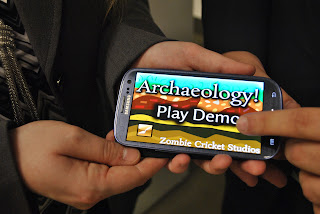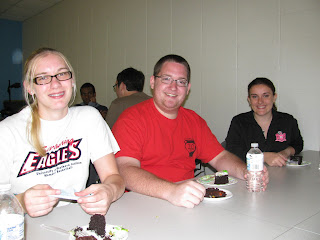 UE Archaeology and History alumna, Lierin Holly-Falzoni (left) has developed a new Archaeology game app designed to teach people some of the basic concepts of archaeology while they play a fun and challenging game. Lierin and her husband, Marco Falzoni (standing beside Lierin) founded Zombie-Cricket Studios, a company that makes game apps.
UE Archaeology and History alumna, Lierin Holly-Falzoni (left) has developed a new Archaeology game app designed to teach people some of the basic concepts of archaeology while they play a fun and challenging game. Lierin and her husband, Marco Falzoni (standing beside Lierin) founded Zombie-Cricket Studios, a company that makes game apps.  Lierin and Marco demonstrated the app (right) to UE students and administrators last week. The game simulates an excavation at a Colonial American site as players draw plans, excavate, and even sift for artfiacts by shaking their phone or tablet!
Lierin and Marco demonstrated the app (right) to UE students and administrators last week. The game simulates an excavation at a Colonial American site as players draw plans, excavate, and even sift for artfiacts by shaking their phone or tablet!
The couple also signed an agreement (below) donating a percentage of their profits from the game to the Department of Archaeology and Art History's Browning-Miller Advancement for Archaeology Endowed Fund. Scholarships supported by the Fund will underwrite the expenses of UE students traveling to field schools or internships beginning next summer. We are all very appreciative of Lierin and Marco's generous donation!











.JPG)






























